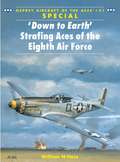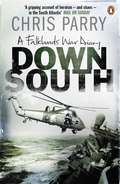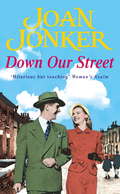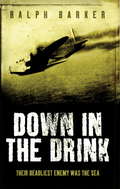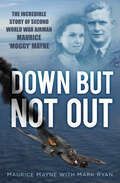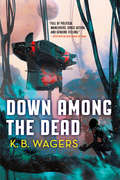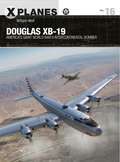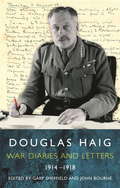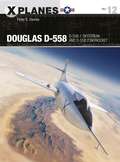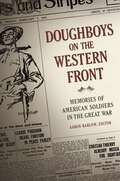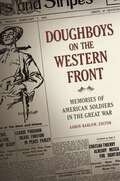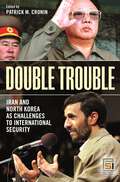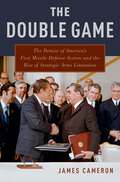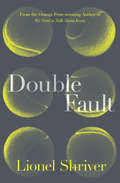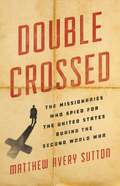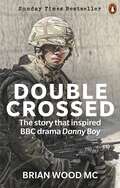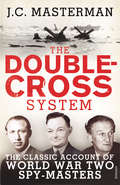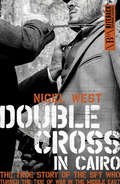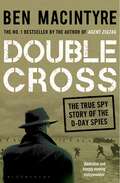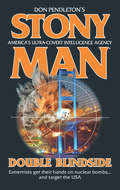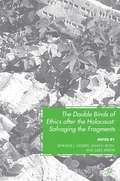- Table View
- List View
‘Down to Earth' Strafing Aces of the Eighth Air Force (Aircraft of the Aces)
by Chris Davey William N HessLike The Long Reach, Down to Earth is a message from the battle at its height, told in their own words by the men who fight' this is how Brig-Gen Francis Griswold, VIII Fighter Command, ends his introduction to this book. His official endorsement reveals just how important a document Down to Earth was to the teaching of tyro fighter pilots heading for action in the ETO. More leading aces were lost to flak whilst ground strafing than to German fighters. In this book William Hess has included biographies of all the pilots that originally contributed to this work back in 1943-44.
‘Down to Earth' Strafing Aces of the Eighth Air Force (Aircraft of the Aces)
by Chris Davey William N HessLike The Long Reach, Down to Earth is a message from the battle at its height, told in their own words by the men who fight' this is how Brig-Gen Francis Griswold, VIII Fighter Command, ends his introduction to this book. His official endorsement reveals just how important a document Down to Earth was to the teaching of tyro fighter pilots heading for action in the ETO. More leading aces were lost to flak whilst ground strafing than to German fighters. In this book William Hess has included biographies of all the pilots that originally contributed to this work back in 1943-44.
Down South: A Falklands War Diary
by Chris ParryDown South by Chris Parry - one man's astonishing diary of war in the Falklands'A gripping account of heroism - and chaos - in the South Atlantic' Mail on Sunday'Compelling, gripping. A vividly written, thought-provoking and engaging account' The TimesIn 1982 Lieutenant Chris Parry sailed aboard destroyer HMS Antrim to liberate the Argentine-occupied Falkland Islands. Parry and his crew, in their Wessex helicopter, were soon launched into action rescuing an SAS party stuck on a glacier in gales that had already downed two others. Soon after they single-handedly pursued and fatally wounded a submarine before taking part in terrifying but crucial drop landings under heavy fire. Down South is a hands on, day-by-day account of war fought in the most appalling conditions by men whose grit and fighting spirit overcame all obstacles.This important and extraordinary book of recent history will be enjoyed by readers of Antony Beevor and Max Hastings.'Gripping. A graphic description of just how they pulled off a real-life Mission Impossible' Daily Express 'Excellent. A fascinating war diary' Daily Telegraph'Vivid and insightful. Parry excels in revealing the day-to-day challenges of fighting a campaign in hostile surroundings' Financial Times'A truly gripping historical account' Niall Ferguson 'A priceless contribution to military history. Riveting' Literary ReviewChris Parry joined the Royal Navy after university and then became an Observer in the Fleet Air Arm in 1979. After the Falklands War he had a successful career in the navy, and on promotion to Rear Admiral in 2005 he became the Ministry of Defence's Director of Developments, Concepts and Doctrines. He was appointed a CBE in 2004. Now retired from the armed services, he heads a company which specializes in geo-strategic forecasting.
Down Our Street: Friendship, family and love collide in this wartime saga (Molly and Nellie series, Book 4) (Paragon Softcover Large Print Bks.)
by Joan JonkerWith a double wedding on the cards, Liverpool's best-loved neighbours plan for an unforgettable day. In Down Our Street, Joan Jonker brings us another instalment of her hugely popular Molly and Nellie series, as the two friends get up to more mischief in their beloved Liverpool. Perfect for fans of Katie Flynn and Lindsey Hutchinson.'Hilarious but touching' - Woman's RealmThe Second World War is finally over and best friends Molly Bennett and Nellie McDonough are bursting with happiness. Their beloved sons are coming home at last and their eldest children are planning to marry each other. When a double wedding is announced, Molly is determined to give her two beautiful daughters a day to remember for the rest of their lives. Meanwhile Nellie's daughter Lily has a boyfriend whom no one likes. When he brings trouble to their door, Nellie's friends in the street are ready to face it. And there's a handsome young chap just waiting in the wings for Lily... What readers are saying about Down Our Street: 'This book is like a breath of fresh air, never have I laughed so much and also cried at the antics of Molly and Nellie''A lovely story that will make you laugh out loud and shed a tear. A story that will touch every emotion. It's so well written that it makes you feel a part of the families'
Down in the Drink: Their Deadliest Enemy Was the Sea (True Stories Of Wwii Ser.)
by Ralph BarkerTo crash or be shot down into the sea is a terrifying experience. And to escape to tell the tale is a rare and remarkable achievement. But that is precisely what each of the World War Two heroes described here has done; they have come 'down in the drink' and miraculously survived. In doing so, they have all qualified for the 'Goldfish Club'. Ralph Barker tells the hair-raising and inspiring stories of eight such air crews. There is the tale of the Beaufort that ditches in the North Sea, the Wellington crew stranded in the Bay of Biscay and the Mosquito fighter-bomber trapped in the sea off Burma, keeping afloaton the wreckage of his fuselage,concussed, his bones broken, withonly a flask of whisky to keep him going. In DOWN IN THE DRINK, the accounts of heroism and endurance match any from that historic time. They are stories of men from all corners of the British Commonwealth fighting for survival against unimaginable odds. No one could read of their experiences without being stirred by the proof they give that there is no limit to human courage.
Down But Not Out: The Incredible Story of Second World War Airman Maurice 'Moggy' Mayne
by Mark Ryan Maurice MayneMaurice ‘Moggy’ Mayne was a cricket-loving air gunner in the Second World War, with a pretty girlfriend back home in rural England. His turret was in a Bristol Beaufort and his pilot had to fly with almost suicidal bravery at giant German warships before releasing the torpedo. No wonder Moggy’s first pilot cracked up and his second liked to drink. When he was shot down, Moggy miraculously survived – unlike his best friend Stan. Moggy was sent to Stalag Luft VIIIB, an infamous German POW camp near the Polish border, where he was badly treated. Fearing losing his beloved girlfriend Sylvia forever, and risking recapture and execution, he saw the chance to escape alone, thus beginning an epic journey through Nazi-occupied Germany. As the Gestapo shot other escaped British servicemen, Moggy Mayne came agonisingly close to lasting freedom. Instead, as the war neared its end, he had to face the horrors of the ‘long march’ west – and he felt his life slipping away. Would he ever see his Sylvia again?
Down Among The Dead (The Farian War Trilogy)
by K. B. WagersGunrunner empress Hail Bristol must navigate alien politics and deadly plots to prevent an interspecies war, in this second novel in the Farian War space opera trilogy.In a surprise attack that killed many of her dearest subjects, Hail Bristol, empress of Indrana, has been captured by the Shen -- the most ruthless and fearsome aliens humanity has ever encountered. As she plots her escape, the centuries-long war between her captors and the Farians, their mortal enemies and Indrana's oldest allies, finally comes to a head.When her captors reveal a shocking vision of the future, Hail must make the unexpectedly difficult decision she's been avoiding: whether to back the Shen or the Farians. Staying neutral is no longer an option. Will Hail fight? Or will she fall?
Douglas XB-19: America's giant World War II intercontinental bomber (X-Planes)
by William WolfIn 1935 the USAAC wanted to build a potential intercontinental bomber, a 'Guardian of the Hemisphere,' and granted Donald Douglas a contract to build the world's largest bomber. The groundwork for the intercontinental bomber had been laid in the previous two decades by the courageous military and civilian pilots who risked their lives to set new distance and endurance records. After World War I the future Axis and Allied nations built larger aircraft and finally during World War II Germany and Japan became intent on developing intercontinental bomber to retaliate against America. While the XB-19 never flew as an intercontinental bomber or even as a combat bomber; its contributions as a 'Flying Laboratory' significantly influenced the development of the Consolidated B-36 Peacemaker, the world's first true intercontinental bomber. Since the XB-19 project was top secret and there was only one example built there is little information remaining for researchers. Over the years Bill Wolf has collected the largest quantity of XB-19 material and a number of photographs, including a copy of the original Army Air Force acceptance of the aircraft, first-hand narratives of its first flight, and other USAAC and Douglas Company documents. This book provides a superbly illustrated history of the XB-19 intercontinental bomber and the text is supported by previously unpublished photographs.
Douglas XB-19: America's giant World War II intercontinental bomber (X-Planes)
by William WolfIn 1935 the USAAC wanted to build a potential intercontinental bomber, a 'Guardian of the Hemisphere,' and granted Donald Douglas a contract to build the world's largest bomber. The groundwork for the intercontinental bomber had been laid in the previous two decades by the courageous military and civilian pilots who risked their lives to set new distance and endurance records. After World War I the future Axis and Allied nations built larger aircraft and finally during World War II Germany and Japan became intent on developing intercontinental bomber to retaliate against America. While the XB-19 never flew as an intercontinental bomber or even as a combat bomber; its contributions as a 'Flying Laboratory' significantly influenced the development of the Consolidated B-36 Peacemaker, the world's first true intercontinental bomber. Since the XB-19 project was top secret and there was only one example built there is little information remaining for researchers. Over the years Bill Wolf has collected the largest quantity of XB-19 material and a number of photographs, including a copy of the original Army Air Force acceptance of the aircraft, first-hand narratives of its first flight, and other USAAC and Douglas Company documents. This book provides a superbly illustrated history of the XB-19 intercontinental bomber and the text is supported by previously unpublished photographs.
Douglas Haig: Diaries and Letters 1914-1918
by Dr Gary Sheffield MA FRHistS Dr John BourneThere's a commonly held view that Douglas Haig was a bone-headed, callous butcher, who through his incompetence as commander of the British Army in WWI, killed a generation of young men on the Somme and at Passchendaele. On the other hand, there are those who view Haig as a man who successfully struggled with appalling difficulties to produce an army which took the lead in defeating Germany in 1918.Haig's diaries, hitherto only previously available in bowdlerised form, give the C-in-C's view of Asquith and his successor Lloyd George, of whom he was highly critical. The diaries show him intriguing with the King vs. Lloyd George. Additional are his day-by-day accounts of the key battles of the war, not least the Somme campaign of 1916.
Douglas D-558: D-558-1 Skystreak and D-558-2 Skyrocket (X-Planes)
by Peter E. DaviesThe six Douglas D-558 research aircraft, built as two variants, were produced for a US Navy and NACA collaborative project to investigate flight in the high subsonic and supersonic regimes and to develop means of coping with the dangerous phenomena of compressibility and pitch-up which had caused many accidents to early jets. Wind tunnels could not provide the necessary data so pilots had to risk their safety in experimental aircraft which, for their time, achieved phenomenal performance. Both series of D-558 were well-designed, strong and efficient aircraft which enabled test pilots to tackle the unknown in comparative safety. Though delayed by their innovative but troublesome power-plants, and limited by the cost of their air-launched sorties, they went well beyond their original Mach 1 speed objective and continued to generate information that provided design solutions for a whole generation of supersonic combat aircraft. Although the final stage of the D-55 programme, the USN's 'militarized' D-558-3, never happened, the Navy was able to apply the lessons of the programme to its much more practical combat types such as the F8U Crusader and F3H Demon. Supported by full-colour artwork including three-view plates of the two D-558 models and a technical view of the D-2 cockpit, this authoritative text offers a comprehensive guide to the record-breaking Navy research craft.
Douglas D-558: D-558-1 Skystreak and D-558-2 Skyrocket (X-Planes #12)
by Peter E. DaviesThe six Douglas D-558 research aircraft, built as two variants, were produced for a US Navy and NACA collaborative project to investigate flight in the high subsonic and supersonic regimes and to develop means of coping with the dangerous phenomena of compressibility and pitch-up which had caused many accidents to early jets. Wind tunnels could not provide the necessary data so pilots had to risk their safety in experimental aircraft which, for their time, achieved phenomenal performance. Both series of D-558 were well-designed, strong and efficient aircraft which enabled test pilots to tackle the unknown in comparative safety. Though delayed by their innovative but troublesome power-plants, and limited by the cost of their air-launched sorties, they went well beyond their original Mach 1 speed objective and continued to generate information that provided design solutions for a whole generation of supersonic combat aircraft. Although the final stage of the D-55 programme, the USN's 'militarized' D-558-3, never happened, the Navy was able to apply the lessons of the programme to its much more practical combat types such as the F8U Crusader and F3H Demon. Supported by full-colour artwork including three-view plates of the two D-558 models and a technical view of the D-2 cockpit, this authoritative text offers a comprehensive guide to the record-breaking Navy research craft.
Doughboys on the Western Front: Memories of American Soldiers in the Great War
by Aaron BarlowCovering the daily lives of American soldiers from their training through their arrival in France and participation in the final battles of the war, this book offers a breadth of perspectives on the experiences of doughboys in the First World War via primary documents of the time.Due to the mechanical typewriter and the Linotype machine, printed materials during the World War I era were produced quickly and widely distributed. In a time without media other than those on paper, printed materials like newspapers, magazines, books, letters, and army orders were critical for communication. This book examines the range of documents written during World War I or within a few years of the end of the conflict to reveal the experiences of the doughboys who participated in "the war to end all wars." Through documents such as military communications, newspaper accounts, personal letters, divisional histories written soon after the end of hostilities, and other sources, readers get detailed glimpses into the doughboy experience during World War I. The book covers subject matter throughout their time as soldiers, including training in the United States and in France, early participation in conflicts, daily life in the American Expeditionary Force, the major battles for American troops, and what returning home was like for those lucky ones. The assembled narrative of the war experience from many different voices and individuals creates a resource that enables a better understanding the attitudes and perspectives from 1918 through the very early 1920s. Readers will also gain an appreciation of the many changes in American culture that were to follow immediately after the war's conclusion and contribute to the decade of the Roaring Twenties.
Doughboys on the Western Front: Memories of American Soldiers in the Great War
by Aaron BarlowCovering the daily lives of American soldiers from their training through their arrival in France and participation in the final battles of the war, this book offers a breadth of perspectives on the experiences of doughboys in the First World War via primary documents of the time.Due to the mechanical typewriter and the Linotype machine, printed materials during the World War I era were produced quickly and widely distributed. In a time without media other than those on paper, printed materials like newspapers, magazines, books, letters, and army orders were critical for communication. This book examines the range of documents written during World War I or within a few years of the end of the conflict to reveal the experiences of the doughboys who participated in "the war to end all wars." Through documents such as military communications, newspaper accounts, personal letters, divisional histories written soon after the end of hostilities, and other sources, readers get detailed glimpses into the doughboy experience during World War I. The book covers subject matter throughout their time as soldiers, including training in the United States and in France, early participation in conflicts, daily life in the American Expeditionary Force, the major battles for American troops, and what returning home was like for those lucky ones. The assembled narrative of the war experience from many different voices and individuals creates a resource that enables a better understanding the attitudes and perspectives from 1918 through the very early 1920s. Readers will also gain an appreciation of the many changes in American culture that were to follow immediately after the war's conclusion and contribute to the decade of the Roaring Twenties.
Double Trouble: Iran and North Korea as Challenges to International Security (Praeger Security International)
by Patrick M. CroninNorth Korea possesses nuclear weapons, while Iran is poised to acquire them in the next decade. How the United States and other nations seek to roll back these burgeoning nuclear powers is among the most urgent issues of the day. At stake is regional security in the Persian Gulf and Northeast Asia, America's standing abroad, and prospects for nuclear non-proliferation. This book offers complementary international perspectives on these threats and the peaceful responses to grapple with the Iranian and North Korean nuclear programs. Leading authorities provide balanced analyses—together with new chronologies and maps—that make the volume an invaluable reference for all those interested in understanding options available in dealing with Iran and North Korea.The contributors to this volume offer complementary international perspectives on the critical security issues that stem from the challenges posed by Iran and North Korea. No other work combines the analysis of the two countries and explores the threat posed by each to regional stability and world order. The book examines how and why attempts to curb the nuclear programs and broader political ambitions of each nation have failed. It also examines how each nation, in its own way, has managed to defy the world's preponderant power, the United States, as well as other major powers and the United Nations. And it offers analysis on where the fractured and oscillating relations with these two nettlesome actors are heading and the long-term implications of their current trajectories for nuclear proliferation, deterrence, alliance management, regional security, and world order.
The Double Game: The Demise of America's First Missile Defense System and the Rise of Strategic Arms Limitation
by James CameronHow did the United States move from a position of nuclear superiority over the Soviet Union at the beginning of the 1960s to one of nuclear parity under the doctrine of mutual assured destruction in 1972? Drawing on declassified records of conversations three presidents had with their most trusted advisors, James Cameron offers an original answer to this question. John F. Kennedy, Lyndon Johnson, and Richard Nixon struggled to reconcile their personal convictions about the nuclear arms race with the views of the public and Congress. In doing so they engaged in a double game, hiding their true beliefs behind a façade of strategic language while grappling in private with the complex realities of the nuclear age. Cameron shows how, despite reservations about the nuclear buildup, Kennedy and Johnson pushed ahead with an anti-ballistic missile (ABM) system for the United States, fearing the domestic political consequences of scrapping both the system and the popular doctrine of strategic superiority that underpinned it. By contrast, the abrupt decline in US public and congressional support in 1969 forced Nixon to give up America's first ABM and the US lead in offensive ballistic missiles through agreements with the Soviet Union, despite his conviction that the US needed a nuclear edge to maintain the security of the West. By placing this dynamic at the center of the story, The Double Game provides a new overarching interpretation of this pivotal period in the development of US nuclear policy and a window onto current debates over nuclear superiority, deterrence, and the future of American grand strategy.
The Double Game: The Demise of America's First Missile Defense System and the Rise of Strategic Arms Limitation
by James CameronHow did the United States move from a position of nuclear superiority over the Soviet Union at the beginning of the 1960s to one of nuclear parity under the doctrine of mutual assured destruction in 1972? Drawing on declassified records of conversations three presidents had with their most trusted advisors, James Cameron offers an original answer to this question. John F. Kennedy, Lyndon Johnson, and Richard Nixon struggled to reconcile their personal convictions about the nuclear arms race with the views of the public and Congress. In doing so they engaged in a double game, hiding their true beliefs behind a façade of strategic language while grappling in private with the complex realities of the nuclear age. Cameron shows how, despite reservations about the nuclear buildup, Kennedy and Johnson pushed ahead with an anti-ballistic missile (ABM) system for the United States, fearing the domestic political consequences of scrapping both the system and the popular doctrine of strategic superiority that underpinned it. By contrast, the abrupt decline in US public and congressional support in 1969 forced Nixon to give up America's first ABM and the US lead in offensive ballistic missiles through agreements with the Soviet Union, despite his conviction that the US needed a nuclear edge to maintain the security of the West. By placing this dynamic at the center of the story, The Double Game provides a new overarching interpretation of this pivotal period in the development of US nuclear policy and a window onto current debates over nuclear superiority, deterrence, and the future of American grand strategy.
Double Fault: A Novel
by Lionel Shriver‘When feminism has become the politics that dare not speak its name, it is refreshing to find an author who will bring such renewed vigour to the gender wars’ Guardian
Double Crossed: The Missionaries Who Spied for the United States During the Second World War
by Matthew Avery SuttonThe untold story of the Christian missionaries who played a crucial role in the allied victory in World War II What makes a good missionary makes a good spy. Or so thought "Wild" Bill Donovan when he secretly recruited a team of religious activists for the Office of Strategic Services. They entered into a world of lies, deception, and murder, confident that their nefarious deeds would eventually help them expand the kingdom of God.In Double Crossed, historian Matthew Avery Sutton tells the extraordinary story of the entwined roles of spy-craft and faith in a world at war. Missionaries, priests, and rabbis, acutely aware of how their actions seemingly conflicted with their spiritual calling, carried out covert operations, bombings, and assassinations within the centers of global religious power, including Mecca, the Vatican, and Palestine. Working for eternal rewards rather than temporal spoils, these loyal secret soldiers proved willing to sacrifice and even to die for Franklin Roosevelt's crusade for global freedom of religion. Chosen for their intelligence, powers of persuasion, and ability to seamlessly blend into different environments, Donovan's recruits included people like John Birch, who led guerilla attacks against the Japanese, William Eddy, who laid the groundwork for the Allied invasion of North Africa, and Stewart Herman, who dropped lone-wolf agents into Nazi Germany. After securing victory, those who survived helped establish the CIA, ensuring that religion continued to influence American foreign policy. Surprising and absorbing at every turn, Double Crossed is the untold story of World War II espionage and a profound account of the compromises and doubts that war forces on those who wage it.
Double Crossed: A Code of Honour, A Complete Betrayal
by Brian WoodAt the age of 23, Brian Wood was thrust into the front line in Iraq, in the infamous Battle of Danny Boy. Ambushed, he led a charge across open ground with insurgents firing at just five soldiers. On his return, he was awarded the Military Cross.But Brian's story had only just begun. Struggling to re-integrate into family life, he suffered from PTSD. Then, five years later, a letter arrived: it summoned him to give evidence at the Al-Sweady Inquiry into allegations of war crimes by British soldiers during the Iraq invasion of 2003.After years of public shame, Brian took the stand and delivered a powerful testimony, and following the tense inquiry room scenes, justice was finally served. Phil Shiner, the lawyer who made the false accusations, was struck off and stripped of an honorary doctorate.In this compelling memoir, Brian speaks powerfully and movingly about the three battles in his life, from being ambushed with no cover, to the mental battle to adjust at home, to being falsely accused of hideous war crimes. It’s a remarkable and dark curve which ends with his honour restored but, as he says, it was too little, too late.
The Double-Cross System: The Classic Account of World War Two Spy-Masters
by Sir John MastermanJ.C. Masterman was chairman of the Double-Cross Committee at the height of World War Two. This is his account of the double agents, deception and counter-espionage which were key to the victory of D-Day. Written as an official report for MI5 in 1945, originally published with the permission of the British Government over twenty years later, The Double-Cross System details the Allied handling of enemy agents and the British infiltration of Nazi spy-rings. Telling the stories of the agents codenamed Zigzag, Tricycle, Garbo and Snow, Masterman also tells the story of a triumphant operation in the Second World War’s intelligence effort.
Double Cross in Cairo: The True Story of the Spy Who Turned the Tide of War in the Middle East
by Nigel WestAs part of the infamous Double Cross operation, Jewish double agent Renato Levi proved to be one of the Allies' most devastating weapons in World War Two. ln 1941, with the help of Ml6, Levi built an extensive spy-ring in North Africa and the Middle East. But, most remarkably, it was entirely fictitious. This network of imagined informants peddled dangerously false misinformation to Levi's unwitting German handlers. His efforts would distort any enemy estimates of Allied battle plans for the remainder of the war. His communications were infused with just enough truth to be palatable, and just enough imagination to make them irresistible. ln a vacuum of seemingly trustworthy sources, Levi's enemies not only believed in the CHEESE network, as it was codenamed, but they came to depend upon it. And, by the war's conclusion, he could boast of having helped the Allies thwart Rommel in North Africa, as well as diverting whole armies from the D-Day landing sites. He wielded great influence and, as a double agent, he was unrivalled. Until now, Levi's devilish deceptions and feats of derring-do have remained completely hidden. Using recently declassified fi les, Double Cross in Cairo uncovers the heroic exploits of one of the Second World War's most closely guarded secrets.
Double Cross: The True Story of The D-Day Spies
by Ben MacintyreD-Day, 6 June 1944, the turning point of the Second World War, was a victory of arms. But it was also a triumph for a different kind of operation: one of deceit, aimed at convincing the Nazis that Calais and Norway, not Normandy, were the targets of the 150,000-strong invasion force.The deception involved every branch of Allied wartime intelligence - the Bletchley Park code-breakers, MI5, MI6, SOE, Scientific Intelligence, the FBI and the French Resistance. But at its heart was the 'Double Cross System', a team of double agents controlled by the secret Twenty Committee, so named because twenty in Roman numerals forms a double cross.The key D-Day spies were just five in number, and one of the oddest military units ever assembled: a bisexual Peruvian playgirl, a tiny Polish fighter pilot, a Serbian seducer, a wildly imaginative Spaniard with a diploma in chicken farming, and a hysterical Frenchwoman whose obsessive love for her pet dog very nearly wrecked the entire deception. Their enterprise was saved from catastrophe by a shadowy sixth spy whose heroic sacrifice is here revealed for the first time. Under the direction of an eccentric but brilliant intelligence officer in tartan trousers, working from a smoky lair in St James's, these spies would weave a web of deception so intricate that it ensnared Hitler's army and helped to carry thousands of troops across the Channel in safety.These double agents were, variously, brave, treacherous, fickle, greedy and inspired. They were not conventional warriors, but their masterpiece of deceit saved countless lives. Their codenames were Bronx, Brutus, Treasure, Tricycle and Garbo. This is their story.
Double Blindside
by Don PendletonSTONY MAN Operating undercover at the President's command, the expert soldiers and cyber techs of the Stony Man team fight for freedom and the rights of the innocent, opposing terrorism in all its deadly forms wherever the need arises.
The Double Binds of Ethics after the Holocaust: Salvaging the Fragments
by Jules Simon J. Geddes J. RothThe Double Binds of Ethics after the Holocaust advances the idea that the Holocaust undermined confidence in basic beliefs about human rights and shows steps of salvage and retrieval that need to be taken if ethics is to be a significant presence in a world still besieged by genocide and atrocity.
